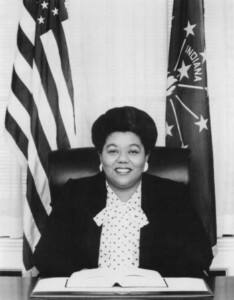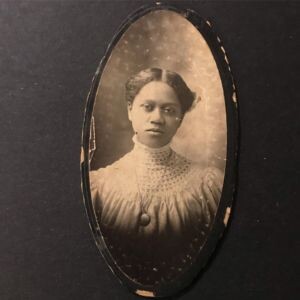February is the month where we take the time to learn all about Black History. We read about the history, learn from the history, and grow forward with a positive mind for all mankind. We always hear about the great things men have done throughout history, but there are some women out there that have really stepped up and done amazing things, too. In this blog post, you will learn about some Black women Hoosiers who turned history upside down in positive ways. So, let’s begin!
Emma Christy Baker (1865-1955)

Emma Christy Baker was born on February 10, 1865 in Salem, Indiana (Washington County) to free African Americans who settled there after moving from South Carolina in the 1830s. Her family moved to Indianapolis when she was still an infant. In Indianapolis, she studied and graduated from Shortridge High School in 1883.
By the time she was 24 in 1889, she had met and married David Baker. He was a barber, and she worked in the Christy family-owned laundromat in Indianapolis where she was well known in the community. Together, they had one son, John Baker, in 1892.
On June 15, 1918, Emma Christy Baker became the first woman as well as the only African American woman to be offered a job as a police officer in the Indianapolis Police Department. Surprisingly, for the time, she made the same pay as her male partners. She had a gift for catching shoplifters and those involved in petty theft crimes. She was appreciated for her fairness in police work by the African American Community.
For the last 16 years of her career as a police officer (1922-1938), Emma worked for the welfare of children. She worked closely with the juvenile courts and the probation department. She was the only African American, man or woman, assigned to this department. Emma was able to attend conferences and truly excel as a police officer. However, in 1938, she was demoted to a matron of the jail. At this time, Indianapolis was introduced to a new police chief who did not want women to be police officers. Emma retired in 1939. It would be another 30 years, 1968, before women were allowed back into the Indianapolis Police force for street-duty.
She died in 1955, and was buried with her husband and son. There was no family left to buy a headstone. Forty-eight years after her death in 2003 the city of Indianapolis came together to provide a marker for her resting place.
Representative Katie Beatrice Hall (1938-2012)

Representative Hall was an educator in Gary, Indiana city schools teaching social studies until she began her campaigns for political involvement. There were a few defeats in the early 1970s, but by 1974, she had been elected to a seat in the Indiana General Assembly.
Here is a timeline of her achievements in her political endeavors:
- Member of the Indiana House of Representatives: 1974-1976
- Member of Indiana Senate: 1976-1980
- Delegate to the Democratic Mini Convention in Memphis, Tennessee: 1978
- Lake County, Indiana Democratic Committee: 1978-1980
- Indiana State Democratic Convention: 1980
In 1982, Katie Hall was nominated for a seat in the United States House of Representatives after the sudden death of US Congressman Adam Benjamin Jr. She defeated the Republican nominee with 63% of the vote for the remainder of Benjamin’s term, and 58% for the full term. The win in 1982 made Representative Hall the first African American to represent the state of Indiana in the US House of Representatives.
One of the most important achievements of her time in the U.S. House of Representatives was campaigning for a national holiday for Martin Luther King, Jr. MLK Day was passed and signed on November 3, 1983. We celebrate MLK Day every year on the third Monday in January.
She continued teaching in Gary, Indiana until her retirement in 2004, and she died in February 2012. Though she may no longer be with us, her legacy still lives on.
Carrie Barnes Ross (1884-1918)

Carrie was born in Kentucky in 1884, and moved to Colorado with her family when she was still a young child. She graduated from Denver High School in 1902. Following her graduation, she attended Columbia University in New York where she graduated from the teacher’s college in 1905. She then moved to Indianapolis, Indiana where she was a teacher in the Indianapolis Public School system.
A Camp Fire group for Black girls was formed in Indianapolis, and Carrie became the group guardian. She attended and was a member of the Second Christian Church, where her work is still positively respected to this day. During her 20s, she also worked closely with the NAACP of Indianapolis and became their secretary.
In 1912, Carrie became a loyal member of the suffrage movement. She was the first president of Branch 7 of the Equal Suffrage Association. This was a group first led entirely by Black men and women in the home of Madam CJ Walker in 1912. They would meet once a month and discuss important matters and issues.
Carrie was quoted saying, “Our meetings are well attended, and both the men and women are enthusiastic. We all feel that colored women have need for the ballot that white women have, and a great many needs that they have not.”
In 1916, she married a dentist and moved to Boston, and continued her activism for getting the right to vote for women. She died two years later due to complications from childbirth. In Carrie’s obituary that was published in the Indy Star, she was still considered a pioneer in Indiana for advocating for the right to vote even though she had moved to Boston.
On January 16, 2020, which was the 100th anniversary of the passage of the 19th Amendment in Indiana, Carrie was recognized by U.S. House Representative Susan Brooks as an integral part of the suffrage movement for the state of Indiana. Her dedication and activism for women’s right to vote led to Indiana becoming the 26th state in the United States to ratify the 19th Amendment on January 16, 1920.
Book Displays
Now that we’ve introduced three famous Black women Hoosiers who changed the course of history for Indiana and beyond, stop by the library during the month of February to check out our many displays relating to Black History Month. It’s important to read, learn, grow together so that we, like Emma, Katie, and Carrie, can make the world a better place to live for everyone.
Sources Used:
Bowling, J. (2020). Biographical Sketch of Carolyn “Carrie” Barnes (Ross). Alexandria, VA: Alexander Street. Retrieved from Alexander Street database.
Fernando, C. (2020, August 27). ‘Black history is American history’: How Black Hoosiers contributed to suffrage movement. Indy Star. (Online Article)
Find a Grave, database and images (https://www.findagrave.com/memorial/49136670/emma-c-baker : accessed 10 February 2022), memorial page for Emma C. Christy Baker (10 Feb 1865–23 Sep 1955), Find a Grave Memorial ID 49136670, citing Crown Hill Cemetery, Indianapolis, Marion County, Indiana, USA ; Maintained by P R P (contributor 47151758) .
